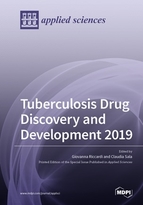Tuberculosis Drug Discovery and Development 2019
A special issue of Applied Sciences (ISSN 2076-3417). This special issue belongs to the section "Applied Biosciences and Bioengineering".
Deadline for manuscript submissions: closed (31 May 2020) | Viewed by 99160
Special Issue Editors
Interests: mycobacterium tuberculosis; drug resistance mechanisms; new drug targets; cystic fibrosis pathogens
Special Issue Information
Dear Colleagues,
We are inviting submissions to the Special Issue of Applied Sciences on Tuberculosis Drug Discovery and Development.
Tuberculosis (TB) still represents one of the principal threats to global health among infectious diseases. The spread of multidrug-resistant (MDR), extensively drug-resistant (XDR), and totally drug-resistant (TDR) clinical isolates constitutes an important challenge for disease control. Research addressing the development of new antitubercular drugs has led to the identification of a few candidates that are in clinical development.
We would like to organize this Special Issue based on the following topics:
- Epidemiology of drug-resistant tuberculosis;
- Host-directed therapy e anti-virulence drugs;
- Mycobacterial cell wall: A source of successful targets for old and new drugs;
- Mycobacterium tuberculosis and benzothiazinones: An update;
- SQ-109 and clinical development;
- DprE1 and MmpL3: two promiscuous targets;
- Delamanid and pretomanid: Two nitroimidazoles in advanced clinical development;
- Bedaquiline against active and latent tuberculosis;
- Telacebec: A new TB drug that interferes with the respiratory chain;
- Delpazolid, a novel oxazolidinone in phase 2 clinical trials;
- Computational chemistry as a novel approach to the development of new molecules.
Prof. Dr. Giovanna Riccardi
Dr. Claudia Sala
Guest Editors
Manuscript Submission Information
Manuscripts should be submitted online at www.mdpi.com by registering and logging in to this website. Once you are registered, click here to go to the submission form. Manuscripts can be submitted until the deadline. All submissions that pass pre-check are peer-reviewed. Accepted papers will be published continuously in the journal (as soon as accepted) and will be listed together on the special issue website. Research articles, review articles as well as short communications are invited. For planned papers, a title and short abstract (about 100 words) can be sent to the Editorial Office for announcement on this website.
Submitted manuscripts should not have been published previously, nor be under consideration for publication elsewhere (except conference proceedings papers). All manuscripts are thoroughly refereed through a single-blind peer-review process. A guide for authors and other relevant information for submission of manuscripts is available on the Instructions for Authors page. Applied Sciences is an international peer-reviewed open access semimonthly journal published by MDPI.
Please visit the Instructions for Authors page before submitting a manuscript. The Article Processing Charge (APC) for publication in this open access journal is 2400 CHF (Swiss Francs). Submitted papers should be well formatted and use good English. Authors may use MDPI's English editing service prior to publication or during author revisions.
Keywords
- tuberculosis
- antituberculars
- drug targets
- antimicrobial resistance
- mycobacterial cell wall
- anti-virulence drugs
- promiscuous targets
- TB drug development
- computational chemistry
- host-directed therapy







